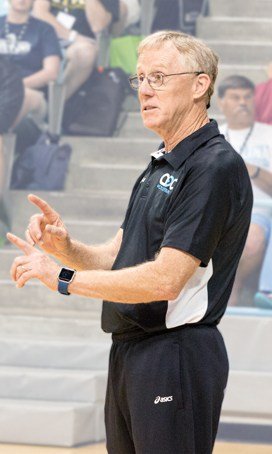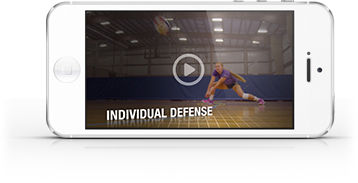Below is a basic recruiting packet that high school and club coaches can download, print and provide to student-athletes. The document is editable so coaches can add additional resources if desired. All of the information in the packet is from NCAA.org; it is a simplified version of the NCAA's full 40-page 2019-2020 guide for the college-bound student-athlete.
School Expectations
Grade 9
- Start planning now! Take the right courses and work hard to earn the best grades possible.
- Ask your counselor for a list of your high school’s NCAA-approved core courses to make sure you take the right classes. Or, find your high school’s list of NCAA-approved courses at eligibilitycenter.org.
- Indoor players need to create a University Athlete account at universityathlete.com.
Grade 10
- If you fall behind on courses, do not take shortcuts to catch up. Ask your counselor for help with finding approved courses or programs that you can take.
- Register for a Profile Page or Certification Account with the NCAA Eligibility Center at eligibilitycenter.org.
- Monitor your Eligibility Center account for next steps.
- At the end of the year, ask your counselor at each high school or program you attended to upload your official transcript to your NCAA Eligibility Center account.
Grade 11
- Check with your counselor to make sure you are on track to graduate on time with the required number of NCAA-approved courses.
- Take the ACT or SAT and submit your scores to the NCAA using code 9999.
- Ensure your sports participation information is correct in your Eligibility Center account.
- At the end of the year, ask your counselor at each high school or program you attended to upload your official transcript to your NCAA Eligibility Center account.
Grade 12
- Complete your final NCAA courses as you prepare for graduation.
- Take the ACT or SAT again, if necessary, and submit your scores to the NCAA using code 9999.
- Request your final amateurism certification beginning April 1 (fall enrollees) or October 1 (winter/spring enrollees) in your NCAA Eligibility Center account.
- After you graduate, ask your counselor to upload your final official transcript with proof of graduation to your NCAA Eligibility Center account.
- Reminder: Only students on an NCAA Division I or II request list will receive a certification.
Division I Academic Standards
Division I schools require you to meet academic standards for NCAA core courses, core-couse grade-point average (GPA) and test scores.
To be eligible to practice, complete and receive athletics scholarships in your first full-time year at a Division I school, you must graduate high school and meet ALL of the follow requirements:
- Complete 16 NCAA core courses:
- 4 years of English;
- 3 years of math (Algebra 1 or higher);
- 2 years of natural/physical science (including one year of lab science if your high school offers it);
- 2 years of social science;
- 1 additional year of English, math or natural/physical science; and
- 4 additional years of English, math, natural/physical science, social science, foreign language, comparative religion or philosophy.
- Complete 10 core courses, including 7 in English, math or natural/physical science, before the start of your seventh semester. Once you begin your seventh semester, you may not repeat or replace and of those 10 courses for GPA improvement.
- Earn at least a 2.3 GPA in your core courses.
- Earn an SAT combined score or ACT sum score that matches your core-course GPA on the Division I sliding scale for students enrolling on or after August 1, 2016.
What is a SLIDING SCALE?
The NCAA Eligibility Center uses a sliding scale to balance your test score and core-course GPA. If you have a low test score, you will need a higher core-course GPA to be eligible. IF you have a low core-course GPA, you will need a higher test score to be eligible.
If you enroll full time at a Division I school after August 1, 2016, and you have not met all Division I academic standards, you may not compete in your first year at college. However, if you qualify as an academic redshirt, you may practice during your first term in college and receive an athletics scholarship for the entire year. The academic redshirt qualification is only for students who enroll full time in college after August 1, 2016.
To qualify as an academic redshirt, you must graduate high school and meet ALL of the following academic standards:
- Complete 16 core courses;
- Earn at least a 2.0 GPA in your core courses; and
- Earn an SAT combined score of ACT sum score matching your core-course GPA on the Division I sliding scale for students enrolling on or after August 1, 2016.
Important Terms
Celebratory Standardized Signing Form: (A form used by Division III institutions.) The Celebratory Standardized Signing Form is a standard NCAA provided, nonbinding athletes celebratory signing form after a college-bound student-athlete has been accepted for enrollment at a Division III school.
Contact: A contact happens any time a college coach says more than “hello” during a face-to-face meeting with you or your parents off of the college’s campus.
Contact period: During a contact period, a college coach may have face-to-face contact with you or your parents, watch you compete, visit your high school, and write or telephone you or your parents.
Dead period: A college coach may not have any face-to-face contact with you or your parents on or off the college campus at any time during a dead period. The coach may write and call you and your parents during this time.
Evaluation: An evaluation happens when a college coach observes you practicing or competing.
Evaluation period: During an evaluation period, a college coach may watch you compete, visit your high school, and write or telephone you or your parents. However, a college coach may not have face-to-face contact with you or your parents off the college’s campus during an evaluation period.
Financial aid (scholarship): Any money you receive from a college or other source, such as outside loans or grants. Financial aid may be based on athletics ability, financial need or academic achievement.
Five-year clock: If you play at a Division I school, you have five calendar years in which to play four seasons of competition. Your five-year clock starts when you enroll as a full-time student at any college. Thereafter, your clock continues, even if you spend an academic year in residence as a result of transferring, decide to redshirt, if you do not attend school or even if you go part time during your college career.
Full-time student: Each school determines what full-time status means. Typically, you are a full-time student if you are enrolled for at least 12 credit hours in a term, but some schools define a full-time student as someone who takes fewer than 12 credit hours in a term.
International student: An international student is any student who is enrolled in a secondary school outside the United States.
Institutional Request List: An Institutional Request List (IRL) is a list of college-bound student-athletes who an NCAA Division I and/or II school is interested in recruiting. The action of activating a college-bound student-athlete to the IRL informs the NCAA Eligibility Center of the school’s interest in having an academic certification decision for the student-athlete.
Official commitment: When you officially commit to attend a Division I or II college, you sign a National Letter of Intent, agreeing to participate in that school for one academic year.
Official visit: During an official visit, colleges can pay for transportation to and from the college campus for you, lodging and meals (Division I allows for up to three meals per day) for you and your parents or guardians, as well as reasonable entertainment expenses, including three tickets to a Division I home sports event. Before a college may invite you on an official visit, you will have to provide the college with a copy of your high school transcript and ACT, SAT or PLAN scores (Division I only) and register for a Certification Account with the NCAA Eligibility Center.
Quiet period: During this time, a college coach may not have any in-person contact with you or your parents off the college’s campus. The coach may not watch you play or visit your high school during this period. You and your parents may visit a college campus during this time. A coach may write or call you or your parents during this time.
Recruited: If a college coach calls you more than once, contacts you off campus, pays your expenses to visit the campus, or in Divisions I and II, issues you a National Letter of Intent or a written offer of financial aid, you are considered to be recruited.
Recruiting calendar: NCAA member schools limit recruiting to certain periods during the year. Recruiting calendars help promote the well-being prospective student-athletes and coaches and ensure fairness among schools by defining certain time periods in which recruiting may or may not occur in a particular sport.
Season of competition: Generally, NCAA rules say that any competition in a season–regardless of the amount of time–counts as having played a season in that sport. If you play ny time during a season, regardless of how long you played, it counts as having played for an entire season in that sport. Your season of competition starts when you spend one second in competition on the field, court, gym or track.
Signing period: The NCAA signing period happens at different times for every sport. This is the period of time in which athletes who have verbal offers from colleges make their athletic scholarship official by signing a National Letter of Intent. During a signing period, athletes can sign their NLI on any day as long as it falls during the specific signing period. Find signing period dates for this year and future years on nationalletter.org.
Ten-semester/15-quarter clock: If you play at a Division II or III school, you have the first 10 semesters or 15 quarters in which you are enrolled as a full-time student to complete your four seasons of participation. You use a semester or quarter any time you attend a class as a full-time student or are enrolled part-time and compete for the school. You do not use a term if you only attend part-time with no competition or are not enrolled for a term.
Two-year college: A school where students can earn an Associate of Arts (AA) degree, an Associate of Science (AS) degree or an Associate of Applied Science degree within two years. Some people call these schools community colleges or junior colleges.
Unofficial visit: Any visit by you and your parents to a college campus paid for by you or your parents. The only expense you may receive from the college is three complimentary admissions to a Division I home athletics contest. You may make as many unofficial visits as you like and may take those visits at any time. The only time you cannot talk with a coach during an unofficial visit is during a dead period.
Verbal commitment: A verbal commitment happens when you verbally agree to play sports at a college. This typically happens before you sign a National Letter of Intent. The commitment is not binding on you or the school and can be made at any time.
Walk-on or Preferred Walk-on: A walk-on is someone who wasn’t recruited by a school to participate in sports and doesn’t receive a scholarship from the school, but who becomes a member of one of the school’s athletics teams.
Scholarships
NCAA Divisions I and II schools provide more than $2.7 billion in athletics scholarships annually to more than 150,000 student-athletes. Division III schools do not offer athletics scholarships.
Only about 2% of high school athletes are awarded athletics scholarships to compete in college. Of the student-athletes participating in sports with professional leagues, very few become professional athletes. A college education is the most rewarding benefit of your student-athlete experience.
Division I schools may provide tuition and fees, room and board, books and other expenses related to attendance at the school. Division II full scholarships cover tuition and fees, room, board and course-related books and supplies. Most student-athletes who receive athletics scholarships receive an amount covering a portion of these costs. Many student-athletes also benefit from academic scholarships, NCAA financial aid programs such as the NCAA Division I Student Assistance Fund and need-based aid such as federal Pell Grants. You must report all financial aid you receive to your NCAA school’s financial aid office. If you have questions about what financial aid can be accepted, contact your NCAA school’s financial aid office and athletics department for help.
Division I schools may provide you with multi-year scholarships. Additionally, Division I schools may pay for you to finish your bachelor’s or master’s degrees after you finish playing NCAA sports.
If a school plans to reduce or not renew your aid, the school must notify you in writing by July 1 and provide an opportunity for you to appeal. In most cases, the head coach decides who receives a scholarship, the scholarship amount and whether it will be renewed.
Contact the NCAA school you hope to attend for more detailed information about NCAA financial aid rules.
National Letter of Intent
By signing a National Letter of Intent, you are agreeing to attend a Division I or II college for one academic year. Participating colleges agree to provide financial aid to you for a minimum of one academic year as long as you are admitted to the school and are eligible for financial aid under NCAA rules.
The NLI is voluntary and not required for you to receive financial aid or participate in sports. Signing an NLI ends the recruiting process because coaches are prohibited from recruiting student-athletes who have signed NLIs with other participating schools.
If you sign an NLI but decide to attend another college, you may request a release from your contract with the school. If you sign an NLI with one school but attend a different school, you lose one full year of eligibility and must complete a full academic year at the new school before being eligible to compete. If you have questions about the NLI, visit nationalletter.org.
Sample recruiting packet was provided by Wave Volleyball Club.
All information provided by NCAA.org. For the most up-to-date information about the recruiting process, visit NCAA.org.
View the NCAA’s full 2019-2020 guide for the college-bound student-athlete




